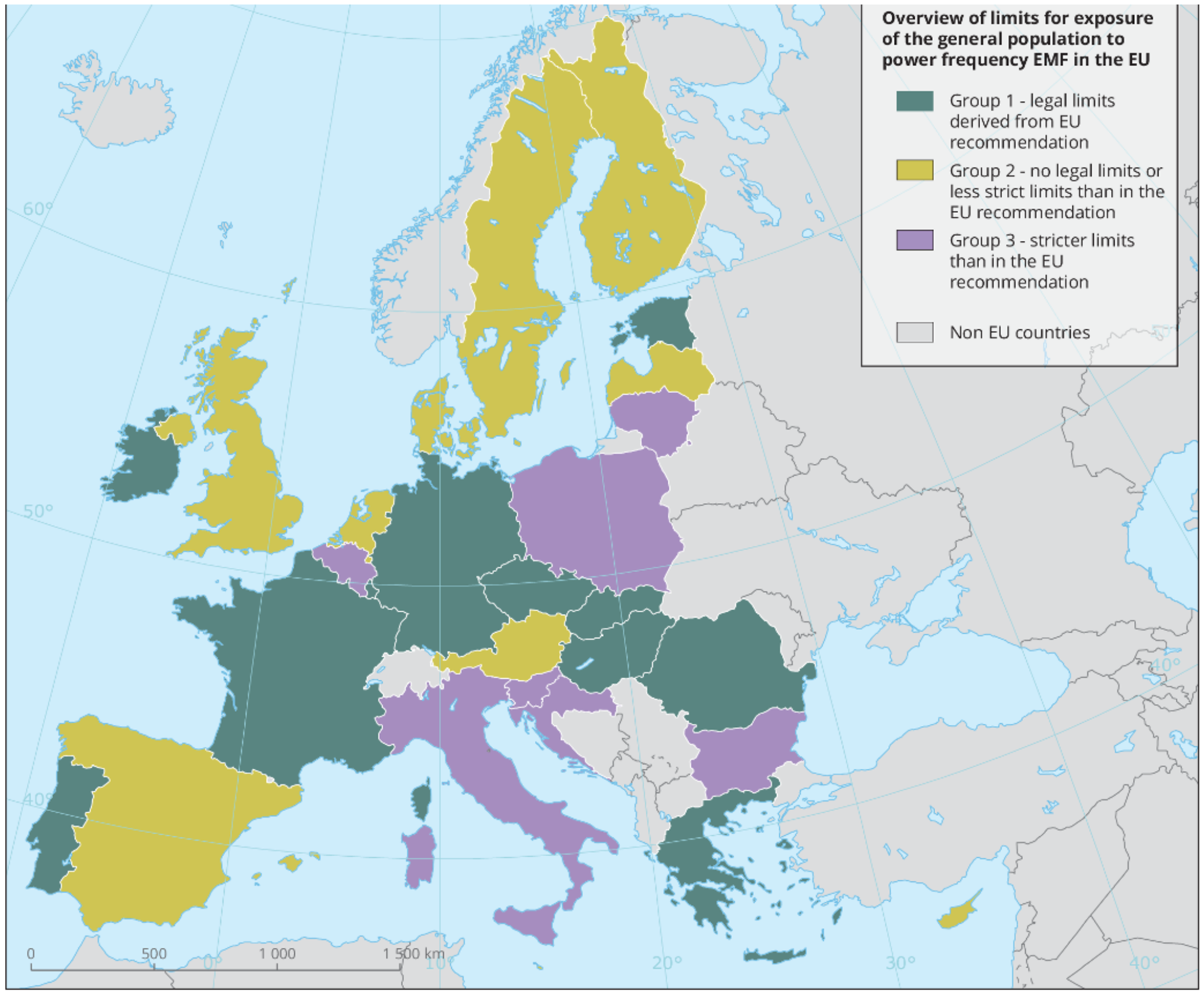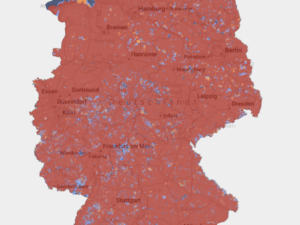- Mobile networks need to follow internationally agreed emission limits to protect human health
- Limits have been inconsistently applied in EU member states: higher thresholds can hinder 5G roll out
- The table below shows the limits adopted in the EU
Links between EMF and 5G policy goals
5G can only be deployed if it meets limits designed to protect the public from exposure to Electromagnetic Fields (EMF). These limits are in place because high levels of EMF can be damaging to human health, causing cancers and affecting fertility. The International Commission on Non-Ionizing Radiation Protection (ICNIRP) has produced guidelines to protect the public from harmful effects associated with EMF. These guidelines at set at 50 times less than the level where there has been substantiated evidence of health damage (see ICNIRP GUIDELINES p484 and 492). A European Council Recommendation (1999/519/EC) set EMF limits based on the ICNIRP guidelines.
The 2018 Electronic Communications Code says protecting public health is “imperative” and urges Member States to take a consistent approach having “particular regard” to Recommendation (1999/519/EC). However, these limits are not binding on Member States and there is inconsistency in how they are applied.
This is of concern for two reasons. Firstly, any country which sets very high limits creates a potential health risk, although we have found no examples of this. Secondly, setting very low limits makes it technically difficult or prohibitively expensive to roll out networks, so restricting the economic and social benefits of mobile technologies, including 5G.
For example, for nearly a decade, mobile operators in the city of Brussels complained about a radiation limit what was considerably lower than the ICNIRP limits and slowed the deployment of their services. This was amended in August 2021 and is now 14.5 V/m limit, significantly higher than the previous limit of 6 V/m, but still the most restrictive in Europe. The World Health Organisation (WHO) recommends a maximum radiation limit of 41.2 V/m. The mobile operator Proximus welcomed the change but said moving towards the WHO standards would “avoid limitations”. In May 2024, Italy announced it would raise its EMF limits from 6 V/m to 12 V/m in a move it said would promote 5G deployment.
Inconsistency in EMF limits
Two pieces of research have highlighted this inconsistency in approaches to EMF limits. The first was carried out by the National Institute for Public Health in the Netherlands in 2018. It said there were three approaches to EMF in EU countries:
- Group 1: the EU recommendation has been transposed in binding national legislation or national policy.
- Group 2: national limits based on the EU recommendation or ICNIRP are not binding, there are more lenient limits or there is no regulation
- Group 3: stricter restrictions based on the precautionary principle or due to public pressure.
This is illustrated in the map below:
 2018 grouping study of EMF limits in Member States
2018 grouping study of EMF limits in Member StatesWork by IDATE and the GSMA published in the previous editions of the 5G Observatory give a similar picture in more detail and is shown in the table below.
As the study progresses we will continue to monitor the any changes in national EMF regulations, bearing in mind that these can have an impact on 5G-related EU policy goals, such as enhancing coverage. We note that currently the following countries all have limits which are stricter than the ICNIRP guidelines: Belgium, Bulgaria, Croatia, Greece, Italy, Lithuania and Luxembourg.
Adoption of ICNIRP limits in the EU-27 Member States plus the UK
| Countries | ICNIRP limits used? | Details |
|---|---|---|
| Austria | Yes | |
| Belgium | No | More restrictive than ICNIRP. Each region has its own limits. |
| Bulgaria | No | Public exposure limit of 0.1 W/m (300 MHz to 30 GHz) |
| Croatia | No | Power density limits are 16% of the ICNIRP guidelines |
| Cyprus | Yes | ICNIRP limits adopted in 2004 |
| Czech Republic | Yes | ICNIRP limits adopted in 2000 |
| Denmark | Yes | |
| Estonia | Yes | ICNIRP limits adopted in 2002. No permit for ERP power <100W |
| Finland | Yes | |
| France | Yes | ICNIRP limits adopted in 2002 |
| Germany | Yes | |
| Greece | No | 60% of ICNIRP guidelines for base stations located less than 300 m from schools, hospitals... 70% of ICNIRP guidelines in other areas |
| Hungary | Yes | ICNIRP limits adopted in 2004 |
| Ireland | Yes | |
| Italy | No | 20 V/m as a general limit in open areas. 12 V/m inside buildings |
| Latvia | Yes | |
| Lithuania | Yes | |
| Luxembourg | No | Limit at 3 V/m per operator and per antenna system. About 0.2% of ICNIRP limit above 2 GHz |
| Malta | Yes | |
| Netherlands | Yes | |
| Poland | Yes | ICNIRP limits adopted in 2020 |
| Portugal | Yes | ICNIRP limits adopted in 2004 |
| Romania | Yes | |
| Slovakia | Yes | ICNIRP limits adopted in 2007 |
| Slovenia | Yes | For sensitive and protected areas limits are lower |
New EU rules on small cells
In June 2020 the European Commission adopted new rules which make it easier to deploy the small cells often used in 5G networks and goes some way to harmonising EMF rules. The Implementing Regulation is binding on all Member States and means that small cells are exempt from individual town planning permits, if they fulfil certain technical and physical criteria.
The small cells must have an equivalent isotropic radiated power (EIRP) of less than 10 Watts, be positioned at least 2.2 metres off the ground and have a maximum volume of 30 litres with a minimal visual impact (see Implementing Regulation, points 5, 6 and 8).
The binding nature of this Regulation and the specifications regarding power levels may make it easier for operators to install very small 5G base stations which otherwise might have fallen foul of EMF regulations in those countries with stricter limits. However, the Regulation is “without prejudice to national measures regarding safety” (ibid, point 15), which may offer space for the continued application of stricter EMF limits.
It will be easier to assess the impact of this Regulation by the end of the year, when Member States are required to make the first report to the Commission on how it has been applied (ibid, Article 4).











